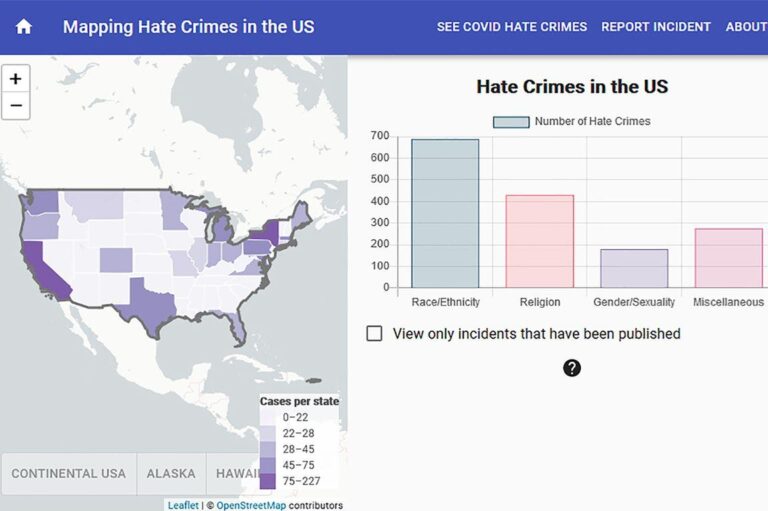Rising Hate Crimes in the U.S.: A Closer Look at Trends, Impacts, and Solutions
Escalation of Hate Crimes in Urban Centers Reflects Growing Societal Strains
Recent data from the Federal Bureau of Investigation (FBI) reveals a marked increase in hate crime incidents across major U.S. cities, signaling intensifying social fractures. Experts attribute this rise to a combination of economic instability, heightened political divisions, and the spread of extremist ideologies. Metropolitan areas including New York City, Los Angeles, and Chicago have experienced significant upticks, with offenses frequently targeting individuals based on race, religion, and sexual identity. These acts not only jeopardize public safety but also erode trust and cohesion within already fragile communities.
Highlights from the FBI’s latest statistics include:
- A 15% year-over-year increase in reported hate crimes nationwide.
- Racially motivated offenses account for more than 60% of cases.
- Sharp rises in anti-Semitic and anti-Asian hate incidents.
- Expanded law enforcement initiatives focusing on community engagement and education.
| City | Yearly Change (%) | Primary Target Group |
|---|---|---|
| New York | 18% | Race |
| Los Angeles | 12% | Religion |
| Chicago | 20% | Sexual Orientation |
| Houston | 10% | Race |
Demographic Insights: Who Is Most Affected by Hate Crimes?
Analysis of recent hate crime data highlights that certain groups bear a disproportionate burden of these offenses, exposing ongoing societal vulnerabilities. Black Americans and Jewish populations have seen notable increases in victimization, while anti-Asian hate crimes, which surged during the early stages of the COVID-19 pandemic, have somewhat plateaued but remain a pressing issue. Researchers note that hate crime hotspots often coincide with regions experiencing political unrest, economic hardship, and demographic shifts.
Patterns in the nature of hate crimes reveal evolving tactics and motivations:
- Verbal abuse and threats dominate reported incidents, frequently occurring both in public venues and on digital platforms.
- Physical violence has slightly decreased but continues to pose a serious threat, especially to marginalized groups.
- Property damage and vandalism commonly target religious and ethnic community centers.
| Group | Yearly Increase (%) | Common Incident Types |
|---|---|---|
| Black Americans | 12% | Physical attacks, verbal harassment |
| Jewish Communities | 15% | Vandalism, threatening language |
| Asian Americans | 5% | Verbal abuse, online harassment |
| LGBTQ+ Individuals | 8% | Physical assault, verbal threats |
Challenges Faced by Law Enforcement and Federal Agencies in Addressing Hate Crimes
Law enforcement agencies encounter multiple hurdles in tackling the surge of hate crimes effectively. A significant issue is the underreporting of these offenses, often due to victims’ distrust of authorities or fear of retaliation. Additionally, proving the bias motivation behind crimes requires detailed investigations, which can be complex and resource-intensive. Variations in training and funding across jurisdictions further complicate consistent enforcement and response.
Federal entities play a pivotal role in supporting local efforts and enhancing nationwide coordination:
- Offering specialized training and financial support to improve detection and prosecution of hate crimes.
- Managing the Hate Crime Statistics Program to ensure comprehensive and accurate data collection.
- Conducting public outreach campaigns to encourage reporting and foster community collaboration.
- Coordinating cross-state investigations targeting organized hate groups.
| Federal Agency | Primary Function |
|---|---|
| FBI | Leads investigations and compiles national hate crime data |
| Department of Justice Civil Rights Division | Enforces hate crime laws and provides victim support |
| Community Relations Service | Facilitates conflict resolution and community mediation |
Strategic Policy Approaches to Mitigate Hate Crimes and Empower Communities
Addressing the growing prevalence of hate crimes requires a multifaceted policy approach that balances enhanced enforcement with the protection of civil rights. Strengthening hate crime legislation with clear definitions and tougher penalties is essential, alongside mandatory bias-awareness training for law enforcement personnel to improve victim response. Increasing funding for dedicated hate crime task forces will bolster data accuracy and inter-agency cooperation, ensuring timely support for affected communities.
Equally important is the promotion of community-driven programs that build resilience and foster inclusivity. Grants supporting local organizations focused on education, dialogue, and cultural exchange can help dismantle prejudices that fuel hate. Public campaigns that amplify the voices and experiences of marginalized groups are vital in cultivating empathy and reducing societal tolerance for hate-driven behavior. Below is a summary of key policy recommendations:
- Robust Legal Reforms: Harmonize and update hate crime laws nationwide.
- Specialized Law Enforcement Training: Establish dedicated units for bias incident response.
- Improved Data Systems: Standardize hate crime reporting protocols.
- Community Investment: Fund grassroots initiatives aimed at prevention and education.
- Public Awareness Efforts: Launch comprehensive anti-bias campaigns.
| Policy Initiative | Anticipated Outcome |
|---|---|
| Enhanced Legislation | Stronger deterrence through increased penalties |
| Law Enforcement Training | Improved victim support and equitable enforcement |
| Community Funding | Empowered local prevention and education programs |
| Awareness Campaigns | Greater public intolerance for hate crimes |
Conclusion: Addressing the Persistent Challenge of Hate Crimes in America
The FBI’s recent findings on the rise of hate crimes highlight a disturbing trend that demands urgent attention from communities, law enforcement, and policymakers alike. Tackling the root causes of bias and discrimination, while enhancing prevention and response mechanisms, is critical to safeguarding the rights and safety of all individuals. Ongoing surveillance, transparent reporting, and collaborative efforts will be key to reversing this upward trajectory and fostering a more inclusive society.







